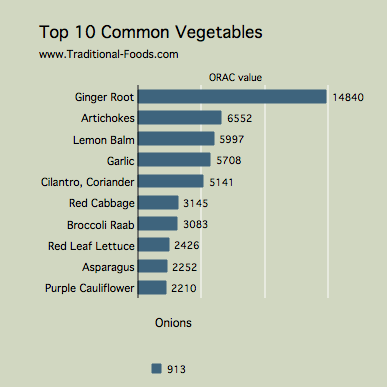Antioxidants in Onions (with Shopping Tips)
Join our large (and growing) community of food-lovers on Facebook. We are regularly inspired by members of this positive community. Come be inspired too.
 Although they do not grow high in the Andes mountains, come from a grove of one square mile in Africa, ripen in a short three-day period after a dry winter and a full moon, or have a multi-level marketing company developing to sell them to us, onions should get our attention. They are an excellent source of a cancer-fighting, heart-healthy, brain-supporting flavonol called quercetin. Onions are inexpensive, they are available at your nearest grocery store, and they are easy to cook.
Although they do not grow high in the Andes mountains, come from a grove of one square mile in Africa, ripen in a short three-day period after a dry winter and a full moon, or have a multi-level marketing company developing to sell them to us, onions should get our attention. They are an excellent source of a cancer-fighting, heart-healthy, brain-supporting flavonol called quercetin. Onions are inexpensive, they are available at your nearest grocery store, and they are easy to cook. In their 2003 book Phenolics in Food and Nutraceuticals, Naczk and Shahidi describe onions as the vegetable highest in flavonoids (though the field of antioxidant research grows by the year) and specifically a flavonol compound quercetin.
Onions are rich in flavonoids and serve as one of the major sources of flavonols such as quercetin, isorhamnetin, myricetin and kaempferol conjugates in the diet. Of these, quercetin is the major flavonol in onions. Levels of quercetin glucosides are much higher in onions than those in other vegetables.We love onions. I hope you do too because we recommend that you eat a mountain of them. When you’re done with the mountain, throw some more onions in the pan, cook them up, and eat some more.
One onion-buying (or onion-harvesting) factoid is that smaller is better. The flavonoids in the onion are more concentrated in a smaller onion, making them more rich in flavonoids, bite per bite (Lee et al. 2008). You might find small onions at a discount because no one else wants them. Buy them and run!
Consider too that cooking may reduce the flavonoids. In a 2008 study of onion flavonoids, researchers found that the flavonoid content in the onion was reduced: frying by 33%; sauteing by 21%, boiling by 14-20%, steaming by 14%, microwaving by 4%, and baking showed no loss (Lee et al. 2008). To some degree, the flavonoids may end up in the cooking water or oil.
For my part, I do not worry about the cooking loss in onions: I can eat about thirty times more onion cooked than raw and, as a result, cooking wins fairly readily.
Eat onions. Eat them often. Eat them how you like them.
ORAC Value of Onions
This portion of the Traditional Foods site is structured around the ORAC value of foods, so I present them to you for onion, although you know that it is one specific component (the flavonoid content) that makes onion shine. The antioxidant level of onions listed in the graph below is the “oxygen radical absorbancy capacity” (ORAC value) for onions — an indicator of the ability of onions to combat pre-cancerous cells. The ORAC value for onions is based on 100 grams — just under one cup of onions. The ORAC value has been collected by the USDA from scientific research on antioxidant in foods.
Onions contains 913 micromoles/litre of Trolox equivalents per 100 grams, the total ORAC value of Onions.
- The H-ORAC value for onions is 900.
- The L-ORAC value for onions is 12.
- The total phenolic content of onions is 23 mg GAE/100 g.
Onions, raw
Read more about antioxidant foods at the Traditional Foods website.
Citations
Seung Un Lee, Jong Ha Lee, Suk Hyun Choi, Jin Shik Lee, Mayumi Ohnisi-Kameyama, Nobuyuki Kozukue, Carol E. Levin, and Mendel Friedman, 2008. “Flavonoid Content in Fresh, Home-Processed, and Light-Exposed Onions and in Dehydrated Commercial Onion Products” J. Agric. Food Chem., 2008, 56 (18), 8541-8548. (Here.)Marian Naczk and Fereidoon Shahidi, 2003. Phenolics in Food and Nutraceuticals. CRC Press 2003. (Here.)


0 comments:
Post a Comment